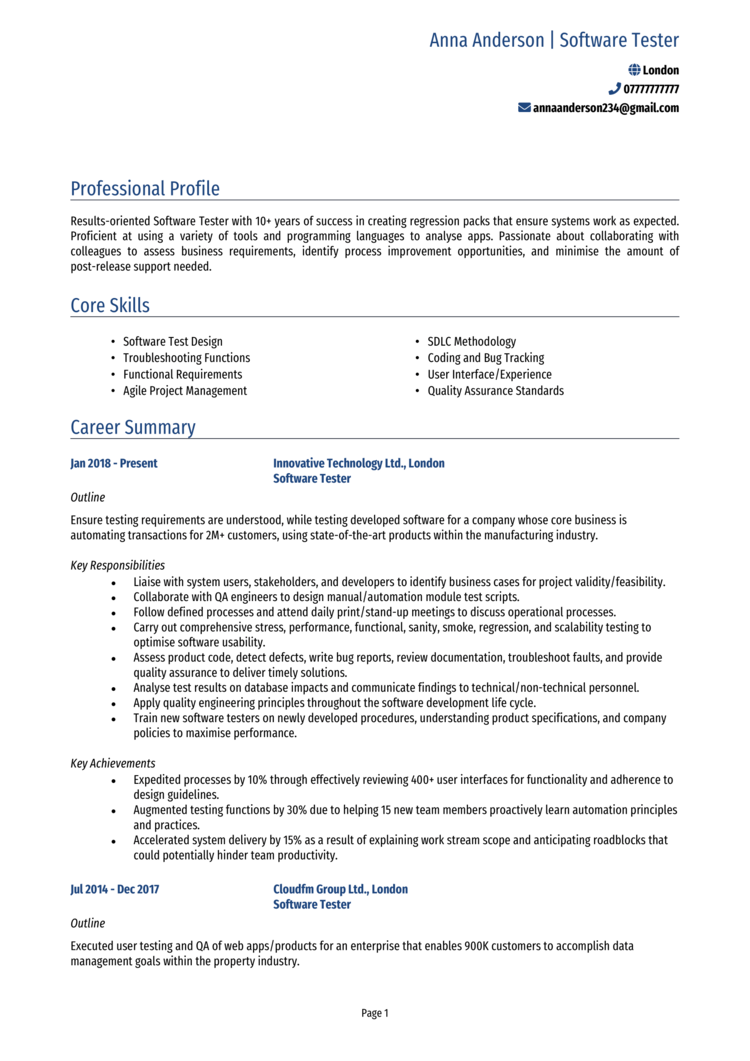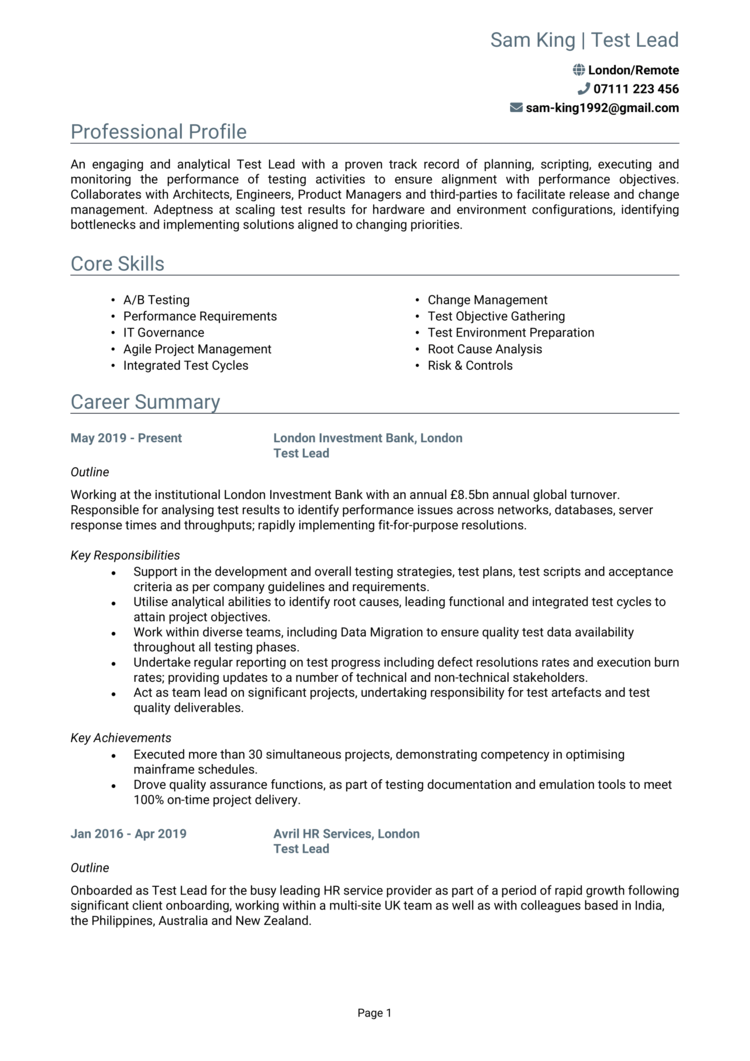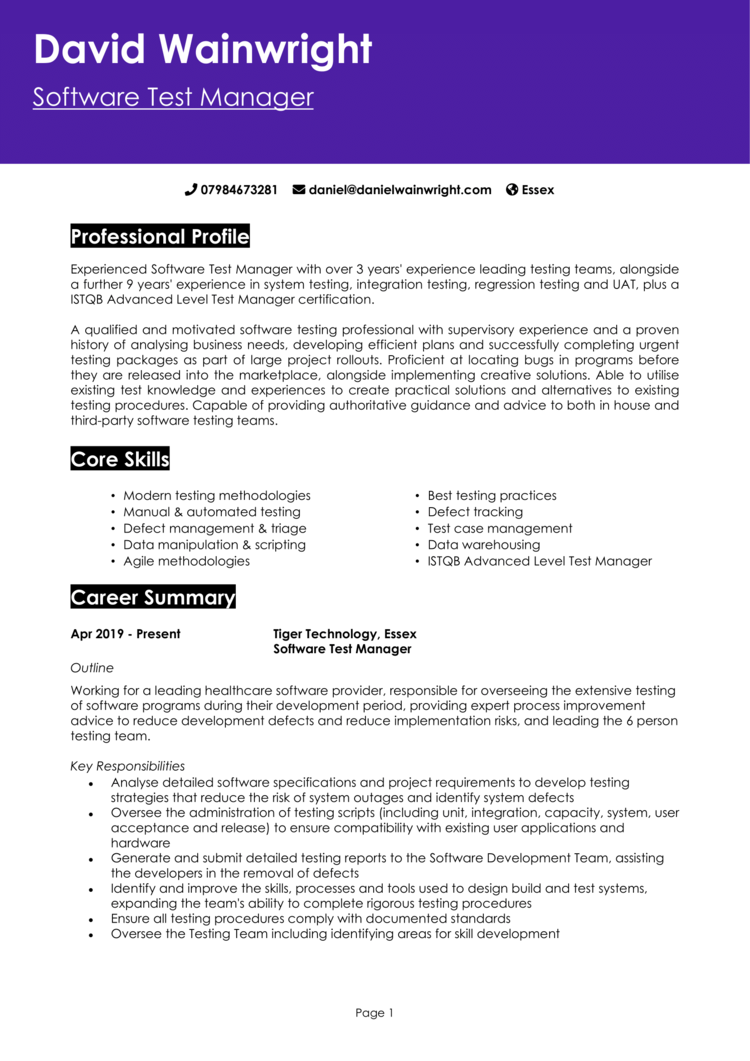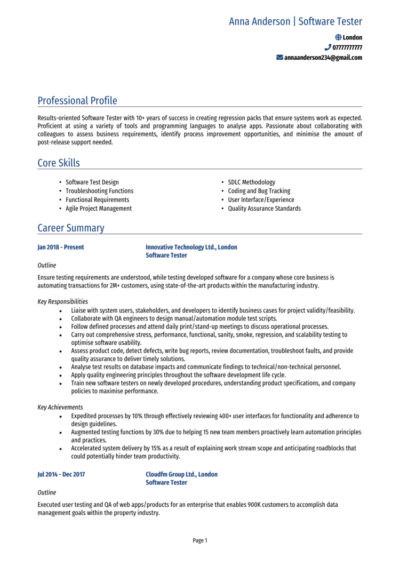You don’t just break software – you make it better. As a Software Tester, you’re the last line of defence between buggy code and the end user, catching issues before they become problems and ensuring a smooth, reliable experience.
But before you start uncovering flaws in someone else’s product, you’ll need a CV that’s bulletproof. This guide, along with Software Tester CV examples, will help you highlight your technical skills and testing expertise so your application performs just as flawlessly as the software you sign off.
Software Tester CV

QA Tester CV

Test Lead CV

QA Analyst CV

Software Test Manager CV

How to write your Software Tester CV
Discover how to craft a winning Software Tester CV that lands interviews with this simple step-by-step guide.
XXWhen you’re writing a CV, you should make sure it’s as error-free as your test reports hope to be. Recruiters don’t want to trawl through unnecessary fluff – they’re scanning for someone who knows their way around bug tracking and QA processes.
This guide will show you how to give your CV maximum impact, whether you specialise in manual testing, automation, or a bit of both. From skills to experience, your CV will pass every hiring manager’s test case.
What’s the right way to structure and format your Software Tester CV?


Your CV should be logically structured and packed with the right information like your best test plan. It should be easy to follow for recruiters who need to quickly understand your qualifications, tools knowledge, and experience in ensuring software quality: a messy structure will only make them move onto other candidates.
Here’s the layout to follow:
- Name and contact details – Ensure your name and personal details are easily visible at the top. A photo is optional and depends on the role.
- Profile – A quick overview that summarises your testing experience, tools proficiency, and what makes you a valuable QA professional.
- Core skills – List technical abilities like test case design, automation frameworks, bug tracking, and agile collaboration.
- Work experience – Showcase your roles in reverse chronological order, clearly detailing your testing responsibilities and achievements.
- Education & certifications – Provide details on your academic background, including your degree, certifications, and specialised training.
- Additional info – Optionally mention side projects, relevant hobbies, professional members, and any related awards.
Stick to a clean, professional font complete with bullet points and clear headings, and aim for a CV no longer than two pages in length. Your format is just as important as its content, so don’t let visual mistakes overshadow your expertise.
How to create a Software Tester CV profile


Your CV profile is your chance to clearly show you’re a tester who ensures software is robust, user-friendly, and fit for release. Keep it sharp and relevant, showing both technical expertise and your approach to quality. If your profile is as generic as ‘Lorem Ipsum,’ recruiters won’t read past the first line: tailor it to the roles you’re applying for.
Software Tester CV profile examples
Profile 1
Detail-oriented Software Tester with four years of experience performing manual and automated testing for web and mobile applications. Skilled in test case design, bug tracking, and regression testing. Proficient in tools such as Selenium, JIRA, and Postman. Committed to ensuring software quality, usability, and functionality through rigorous testing processes.
Profile 2
Analytical Software QA Tester with three years of experience validating software functionality across multiple platforms in agile development environments. Experienced in writing test plans, executing test scripts, and documenting defects. Proficient in using tools like TestRail, Git, and SQL for test data validation. Dedicated to delivering high-quality software solutions.
Profile 3
Experienced Software Tester with over five years of expertise in end-to-end testing, automation scripting, and continuous integration practices. Strong background in system testing, performance testing, and UAT support. Skilled in using Cypress, Jenkins, and REST API testing tools. Focused on ensuring reliability and performance across all development stages.
Details to put in your Software Tester CV profile
Here are some tips on what to include:
- Testing background – Mention manual, automated, or hybrid testing experience.
- Tools & frameworks – Include key ones like Selenium, JIRA, Postman, TestRail, or others relevant to the role.
- Soft skills – Emphasise analytical thinking, communication, and collaboration with dev teams.
- Project exposure – Mention the types of projects or systems you’ve tested (e.g., web apps, mobile platforms, APIs).
- Career goals – Clearly state what you’re looking for next, such as growth into automation, QA leadership, or domain-specific roles.
Presenting your core skills


Your skills section should help recruiters quickly verify you’ve got what it takes to find, document, and verify bugs – efficiently and accurately. Recruiters are scanning for specific keywords, so take them from the job description and put them front and centre.
Tailor this section to the job spec, clearly listing your best assets. These might include test case creation, test automation (e.g., Selenium, Cypress), functional testing, regression testing, Agile/Scrum familiarity, API testing, or performance testing.
Essential skills that recruiters look for in a Software Tester CV
- Test Case Design and Execution – Creating and running structured test cases to validate software functionality against requirements.
- Bug Tracking and Reporting – Identifying, documenting, and reporting defects using tools like Jira, Bugzilla, or Azure DevOps.
- Manual Testing – Performing exploratory, regression, and user acceptance testing to ensure software reliability.
- Automated Testing – Writing and executing automated test scripts using tools such as Selenium, TestNG, or Cypress.
- Functional and Non-Functional Testing – Evaluating software performance, usability, security, and compatibility across platforms.
- Test Plan and Strategy Development – Contributing to the creation of comprehensive test plans aligned with project timelines and goals.
- Agile and Scrum Methodologies – Collaborating with development teams in Agile environments to deliver iterative testing feedback.
- Continuous Integration Testing – Integrating automated tests within CI/CD pipelines using tools like Jenkins or GitLab CI.
- Defect Lifecycle Management – Monitoring the status of bugs through resolution, re-testing, and closure.
- Documentation and Reporting – Maintaining clear records of test results, coverage, and quality metrics to support product releases.
How to highlight work experience


Now it’s time to show what you’ve tested, how you’ve contributed, and what value you delivered. Your work experience section is your chance to prove that you’re not just familiar with testing – you’ve done it successfully, in the real world, under tight deadlines and pressure. Employers want proof of hands-on experience.
Start with the most recent or relevant testing role and move backwards. Emphasise the environments you worked in (Agile, DevOps, Waterfall), the platforms tested (e.g. iOS, Android, Web), and the impact of your work – such as reducing release bugs or improving test coverage.
New to the industry? Include relevant projects, internships, or even personal testing work that demonstrates real QA skills.
How to make your past experience easy to read for employers

- Outline – Introduce the employer and the types of projects or platforms you tested.
- Responsibilities – Highlight key testing tasks such as writing test cases, executing test plans, or reporting bugs. Use action verbs like “executed,” “automated,” and “documented.”
- Achievements – Emphasise results like reducing production bugs, increasing test efficiency, or contributing to successful launches. A great tip is to include figures that make your achievements feel more tangible and real.
Example job entries for Software Testers
Software Tester | BluePeak Systems
Outline
Tested web-based applications for a fast-growing fintech software provider, ensuring high performance and bug-free releases across multiple product lines.
Responsibilities
- Designed and executed manual test cases based on product requirements and user stories.
- Logged, tracked, and verified defects using JIRA, working closely with developers to resolve issues.
- Conducted smoke, regression, and functional testing in both staging and production environments.
- Collaborated with QA leads to review test plans and improve testing efficiency.
- Provided feedback during sprint planning to identify potential testing challenges.
Achievements
- Detected and documented over 300 bugs, contributing to improved product stability.
- Reduced regression testing time by 40 percent through reusable test case templates.
- Helped improve release quality, reducing post-deployment issues by 25 percent.
QA Tester | NexaTech Digital
Outline
Performed functional and API testing for a global e-commerce platform, ensuring robust and reliable customer-facing applications.
Responsibilities
- Created and maintained test scripts using Postman for REST API testing.
- Tested user interface components across browsers and mobile devices for consistency.
- Participated in sprint reviews and retrospectives as part of a cross-functional agile team.
- Validated back-end data using SQL queries to confirm business logic integrity.
- Prepared daily and weekly test reports for QA and development teams.
Achievements
- Identified and helped resolve a critical API defect that was impacting 10,000+ users.
- Improved bug reporting quality, resulting in faster resolution times by developers.
- Played a key role in maintaining a 98 percent uptime during multiple releases.
Automation Tester | Lynk Solutions
Outline
Developed and executed automated test scripts for a cloud-based HR software suite, supporting rapid deployment cycles and continuous integration workflows.
Responsibilities
- Built and maintained automated test scripts using Selenium WebDriver and Java.
- Integrated automated tests into CI/CD pipelines using Jenkins.
- Collaborated with developers to identify test coverage gaps and optimise frameworks.
- Performed load and performance testing to evaluate system scalability.
- Wrote test documentation, including test strategy, traceability matrices, and test summary reports.
Achievements
- Increased test coverage by 50 percent through automation of repetitive test cases.
- Reduced testing time by 60 percent, accelerating release cycles across the QA team.
- Recognised for improving the reliability of test results and supporting early bug detection.
Education and qualifications section


Software testing roles don’t always require formal degrees, but relevant qualifications and certifications boost your credibility. Include degrees (e.g. Computer Science, IT) as well as short courses and vendor certifications.
Your education section should be significantly shorter than the rest of your CV, as practical experience is always most important to recruiters.
Best qualifications for Software Testers
- ISTQB Certified Tester (Foundation Level) – Industry-standard qualification for QA professionals.
- Certified Agile Tester (BCS) – Proves you understand Agile testing environments.
- Bachelor’s Degree in Computer Science or Software Engineering – Strong academic foundation for most QA roles.
- Test Automation Bootcamps (e.g., Selenium, Cypress) – Shows up-to-date technical knowledge in automation.
- Postman or API Testing Certification – Valuable for testers working on back-end or integration-heavy systems.





